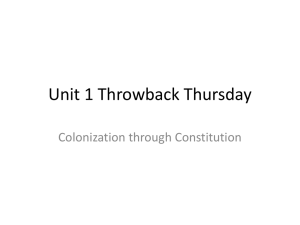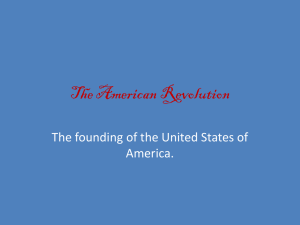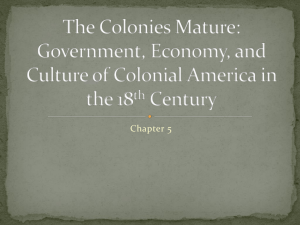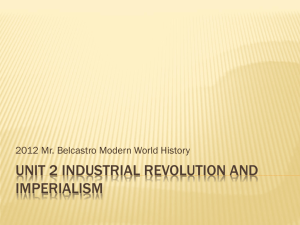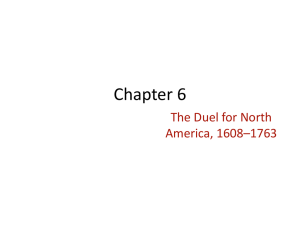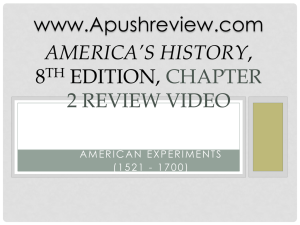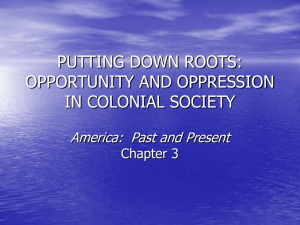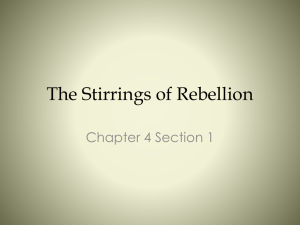File
advertisement
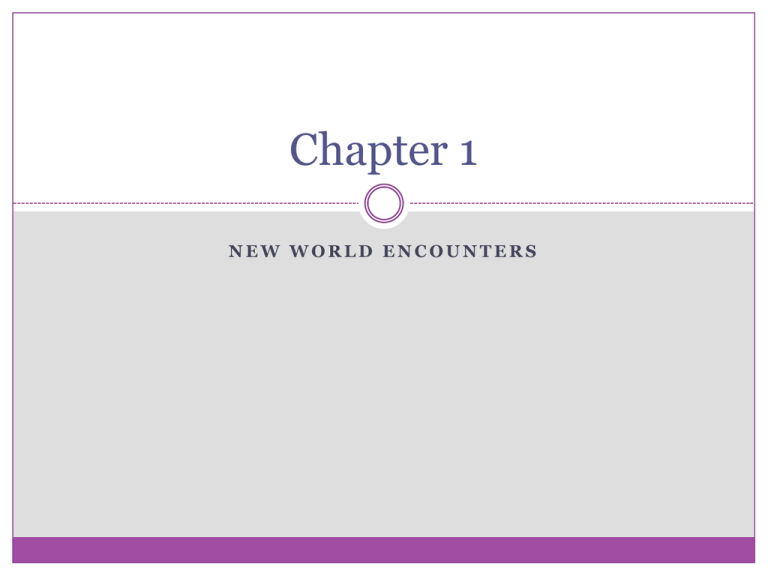
Chapter 1 NEW WORLD ENCOUNTERS Native American Histories before Conquest Humans occupied part of the Western Hemisphere thousands of years before the European discovery of America. Environmental conditions spurred ancient settlement as glaciers moved south and uncovered a ______ __________ connecting Asia and N. America, across which came the Paleo-Indians Food, climate, culture and especially global warming ended the Ice Age, allowing Native American cultures to expand their populations and where they lived. As food sources changed due to the ____________ Revolution, so did their cultures, and soon they developed semi-agricultural societies of considerable sophistication Three of those societies included: Cahokia Native American city near present day St. Louis. Rivaled European cities in size and sophistication Aztecs Complex and successful empire in central Mexico. Tenochtitlan, center of Aztec culture, contained 250,000 inhabitants Eastern Woodland formed along the NE Atlantic coast, into the Great Lakes. Diverse and mobile community of hunters, gatherers, and farmers A World Transformed N.A. were profoundly changed by contact with Europeans. Some good, mostly bad Good: Iron tools Some adopted Christianity BAD: •Seen as the main obstacles to settlement •European trade goods quickly became a part of N.A. culture, and their efforts to gather furs for trade upset the ecological balance •This also caused increasing tension between tribes as competition increased. •N.A. not killed in battle died as a result of disease brought by Europeans to the Americas Imagining a New World Spain France England •With explorers like Christopher __________ leading the way, Spain established the largest colonial empire in the New World. •The _____________ were independent adventurers that led the Spanish movement in carving out a colonial empire •After initial forays for riches, Spanish government officials brought some order, class and caste distinction, and Catholicism to the empire •Later, the French, without much support from the Crown, settled parts of North America. •They main trade was that of _______ •The French lived and worked more cooperatively with the Native Americans to trade with them as well as convert them to ___________ •Began to venture to North America in the latter 15th c. in search of the mythical _______ __________, a short route to Asia •One reason for the delay was the __________ Reformation, in which Henry VIII broke from the Catholic Church •_________ I settled the religious debate and established the _________ Church •The English conquest of __________ was used as a testing ground for theories of colonial rule An Unpromising Beginning: Mystery at Roanoke ROANOKE Sir Walter Raleigh tried and FAILED Multiple Choice 1 1. The peopling of America was made possible some 30,000 years ago because of A. a long period of global warming B. the domestication of horses C. new canoe technology D. bitter intertribal wars in Asia E. the onset of the Ice Age Answer: E Multiple Choice 2 2. The first migrants to the New World came from A. Western Europe B. Asia C. Africa D. Australia E. Southwest Answer: B Multiple Choice # 3 3. Columbus originally was determined to prove that A. A westward water route to China existed B. the world was not flat C. the continents of North and South America existed D. The lost continent of Atlantis was actually part of South America E. the world was smaller than scientists believed at the time Answer: A Multiple Choice # 4 4. Geographically, the French claimed and settled A. the southwest B. the Atlantic seaboard C. the Mississippi Valley and Canada D. Brazil E. the Southeast Answer: C Multiple Choice # 5 5. What 16th c. European upheaval had a profound impact upon England’s settlement of the New World? A. the Crusades B. the War of the Roses C. the Hundred Years’ War D. the experience of the Marian exiles E. the Reformation Answer: E FRQ Describe the effect of European exploration and colonization on African and Native American cultures. How did each group react to these confrontations of societies? Although the reasons varied by nation, all European nations’ desires for exploration revolved around three central themes. Those themes were the quest for gold and spices, the desire to spread Christianity, and a desire to utilize new technologies. This then had a huge impact on all three continents. Each continent had negative and positive consequences. Positive consequences included trading of crops between continents thus stabilizing the diets and nutrition of each continent. Another positive consequence was the exchange of and growth of cultures through diffusion. Negative consequences were African slavery, annihilation of Native American populations and cultures and the damage of two continents’ ecosystems. New World Experiments: England’s 17th c. colonies CHESAPEAKE: DREAMS OF WEALTH Virginia Joint Stock company (namely the London Co) built Jamestown. Experience trouble because of a hostile environment Maryland Sir George Calvert and son Cecilius (the Lords of Baltimore) acquired a royal charter to set up Maryland Saved by John Smith who established military order. London Co. also sent more people to populate the colony Tobacco as a commercial crop was the key to eventual success. House of Burgesses established the first gov’t in the Americas The second Lord Baltimore insisted on religious toleration Reinventing England in America Pilgrims First went to Holland John Winthrop Massachusetts Bay Colony Democratic Town Meetings Religious Dissent Anne Hutchinson/RogerWilliams New Hampshire Connecticut New Haven Rhode Island Diversity in the Middle Colonies New York •Originally New Netherland •Settled by Dutch, Finns, Swedes, Germans, and Africans •England wrested the colony from the Dutch and renamed it New York •Diverse and huge area-meant bureaucratic problems for the Crown New Jersey •Originally a proprietary colony owned by Lord Berkeley & Sir George Cateret •Split when Quakers bought land there •Never really prospered like NY •Struggled with discord and political conflicts Pennsylvania •Quakers settled in Pennsylvania •Quaker theologyeveryone possessed an “inner light” that offered salvation •William Penn tried to establish a complex society based on Quaker principles •Colony promoted aggressively welcoming people of all faiths and nationalities Deleware Planting the Carolinas and The Founding of Georgia Carolinas Georgia Settled by the English Utopian Vision Anthony Ashley Cooper, Earl of Shaftesbury Wealthy families from Barbados N. Carolina S. Carolina 1729 General James Oglethorpe Debtors prison from London Struggled in the early years Multiple Choice #1 1. Unlike Virginia, Maryland was established A. as a commercial center B. as a frontier outpost to secure the area from the French C. by French Huguenots D. as a religious sanctuary for persecuted Catholics from England E. by a commercial trading company Answer: D Multiple Choice #2 2. The major difference in the founding of the colony of Georgia was A. it was a royal colony in which the king paid the governor’s salary B. religious differences between England and its colonists C. an act of aggression and defense from the Spanish D. the colony was not heavily populated by natives E. All of the above were differences between all of the rest of the colonies and Georgia Answer: C Georgia became a royal colony after it’s founding. Choice A is not correct because the question asks about the time the colony was founded. When Georgia was founded, it was feared that the Spanish would attach S. Carolina. Carolinians took hold of Spanish land to build that buffer. Multiple Choice #3 3. The main staple of the Carolinas’ economy by the close of the 17th c. was A. cotton B. rice C. tobacco D. timber E. indigo Answer: B The geography of S. Carolina was conducive for rice production. However, it did not become a staple until after 1690 Multiple Choice #4 4. The Plymouth Colony was ultimately absorbed by which colony? A. Maryland B. Pennsylvania C. Virginia D. Massachusetts E. Deleware Answer: D Multiple Choice #5 5. Anne Hutchinson’s skillful self-defense at her trial before the Bay’s magistrates was ruined by A. her affinity for the dictum of works B. her claim of personal revelation C. her reliance on the Scriptures D. her rejection of free grace E. the fact that she was female Answer: B The revelation was tantamount to heresy FRQ Compare and contrast the English colonies of the Chesapeake with their counterparts at Massachusetts Bay. What were their similarities and their differences? Massachusetts Bay colonies were established as refuges. The first colonies were refuges from religious persecution in England. Then ultimately, the other colonies were established as refuges from the Bay colonies. The Chesapeake colonies may have originally been refuges from religious persecution. These colonies established themselves as heterogeneous colonies that led to cultural diversity. This diversity affected the political, cultural and economic development of the colonies Putting Down Roots: Opportunity and Oppression in Colonial Society SOCIAL ORDER IN THE 17TH C. Early settlers •Grouped into families-more stable base •Population grewincrease in human longevity •Open spaces/pure drinking water/cool climate helped retard the spread of disease and promoted good health Town and Church Women •Family foundation •Lacked economic, political and legal •Family was also rights the basis for educating children •Contributions were essential for a •As towns grew, successful they were required household to open schools supported by local •Worked on family taxes farms and managed the home Colonials •Social groups: •Economic groups: •Provincial gentry •Yeoman •Indentured servants •Most northern colonists were YEOMAN farmers The Challenge of the Chesapeake Environment Family Life Economy •Not favorable for survival •Tobacco shaped society •Contagious disease & contaminated drinking water •Great planters controlled estates and the labor of indentured servants or slaves •Most colonists arrived alone •Freeman formed the largest class •Imbalance between the number of men and women •Cities/towns slow to develop •Childbearing was extremely dangerous •Social mobility hard to attain Race and Freedom in British America Africans 11 million Thought to be barbarous and heathens Whites drew up slave codes African responsedeveloped their own unique African American culture Creole Rise of a commercial empire Mercantilism Regulatory policy-increase exports, decrease imports, and grow richer at the expense of other European states Navigation Acts (beginning in 1660) Board of Trade Oversee colonial affairs Limit competition Shipping guidelines and a list of enumerated goods that could flow from the colonies to England Colonial Factions spark political revolt, 1675-1691 Bacon’s Rebellion (1676) Salem Witch Trials (1692) King Philip’s War (1675) The Glorious Revolution Jacob Leisler John Coode Multiple Choice #1 1. In _________, charges of witchcraft caused considerable turmoil in the late 17th c. A. Salem B. London C. Dedham D. Boston E. New York Answer: A Multiple Choice #2 2. Puritans viewed which of the following as essential to their New England commonwealth? A. strict adherence to personal hygiene measures B. a flexible form of colonial administration C. a healthy family life D. the rapid creation of an urban society in New England E. honest public officials Answer: C Multiple Choice #3 3. In 1647, the Massachusetts legislature ordered all townships with 15 or more families to ______ and support with local taxes A. provide police services B. establish fire departments C. hire a doctor D. elect a mayor E. open an elementary school Answer: E Multiple Choice #4 4. The most important difference between the New England and Chesapeake colonies was A. B. C. D. E. found in their different forms of agricultural production the Chesapeake’s much higher mortality rate based on the differences between their respective proprietors the Chesapeake’s much greater emphasis on the family their different religions Answer: B All of the answers are plausibly correct. However, the key phrase in this question is “most important difference” The mortality rate retarded the growth of the Chesapeake Bay region. Multiple Choice # 5 5. British authorities based their colonial commercial policies on the theory of A. feudalism B. monopolism C. federalism D. mercantilism E. republicanism Answer: D FRQ Compare and contrast social and economic life in 17th c New England with that of the Chesapeake colonies New England social and economic life centered around the concept of church first. Once the religious obligation goes away, the individual is safe. The resources in this region really affect this idea. These colonies also have difficulties because of the homogeneous nature. When someone objects the person becomes ostracized. The heterogeneous nature of the Chesapeake colonies allow for worship as one sees fit. This then enhances a viable economy. Experience of Empire 18th century America Scotch-Irish •Arrived in great numbers in the 18th c Germans •They combined the 2nd largest group of nonEnglish settlers Convicts Native Americans •Comprised a large •Migrated to the group of western immigrants backcountry and joined existing •Many were more •Between 1715 and confederacies of interested in •First came for 1775, some 50000 Indian tribes improving their lot religious toleration convicts were rather than finding shipped to •The Indians religious freedom •then soon came America from interacted, traded (think of “Joseph” for material gains Britain to be and compromised in Far and Away) employed as with Europeans as •Mostly settled in indentured much as possible the middle servants colonies, especially Pennsylvania Spanish borderlands of the 18th c What happened?! •Spanish outposts in North America grew very slowly •Spanish colonials exploited and enslaved Native Americans •Settlements lacked the resources for sustained growth Impact of European ideas on American culture Urban Populations remained small, but grew quickly. American cities were trading ports Americans accepted and followed many of the ideals of the European Enlightenment Ben Franklin was the true 18th c American rep. He became the symbol of material progress American indeptedness increased dramatically after 1690 after Americans imported far more commodities than before. Economic Transformation England remained the most important trading partner for the colonies Religious Revivals in Provincial Societies The Great Awakening had a profound impact in colonial America and cause colonists to rethink their basic assumptions about church and state institutions It brought a profound infusion of evangelical exhortations and revival spirit Preachers like ________ and __________ vividly depicted the horrors of hell to captivated audiences in an effort to restore religious vitality. The movement swept the colonies through the work of _________ preachers Clash of political cultures English American •Divided political power between the monarch and his council of advisors •Colonists attempted to recreate British-style institutions •Two chamber Parliament, each group providing a “check” on the ambitions of the others •Legislative assemblies helped offset the ineptitude of royal governors •Reality: vulnerable to corruption •Commonwealthmen observed that many of England’s rulers were corrupt and institutions were no longer in balance •Colonial assemblies were often aggressive in asserting power, as they fought to protect the rights of American colonists Century of Imperial War King William’s and Queen Anne’s Wars King George’s War Resulted in little change in territorial control Ben FranklinAlbany Plan Proposed a most ambitious plan for common colonial defense and western expansion Revealed the capability of America colonial forces in waging war against the French The Seven Years’ War Showdown for N.American supremacy 17561760. English prevailed Multiple choice #1 1. The largest group of white, non-English immigrants to the colonies were A. the Dutch B. the Germans C. the Swedish D. the Scotch-Irish E. the French Answer: D Multiple Choice #2 2. _________ was the most important embodiment of the Enlightenment in America. A. Jonathan Edwards B. Ben Franklin C. John Locke D. Isaac Newton E. Thomas Jefferson Answer: B Multiple Choice #3 3. Which of the following wars between England and France had the greatest political and economic impact on colonial America? A. King William’s War B. Queen Anne’s War C. King George’s War D. the Seven Years’ War E. the War of the League of Augsburg Answer: D Multiple Choice #4 4. What did the Great Awakening, intercolonial trade, and the rise of the colonial assemblies have in common? A. they created disdain for England B. they created a rebellious spirit in America C. they exacerbated the problems of an already divided citizenry D. they helped create imperial rivalry between England and France E. they all contributed to a growing sense of shared identity among the colonists Answer: E Multiple Choice #5 5. ________ was responsible for authoring the Albany Plan A. Ben Franklin B. Jonathan Edwards C. John Locke D. Isaac Newton E. Thomas Jefferson Answer: A FRQ Discuss the ways that the Anglo-American economic relationship changed during the 18th century. Further, discuss what impact those changes had upon the colonial economy The American Revolution: From Elite Protest to popular revolt, 1763-1783 Supreme Authority: King George III, and Parliament “No Taxation without Representation” became the American motto while seeking freedom from England’s revenue taxation American ideology: heavy religious and moral components based on the Great Awakening and John Locke Eroding the Bonds of Empire Grenvill e insisted Amer pay for Brit troops Britain transferred troops to Boston Opposition to Britain’s Stamp Act Passed the Townshend Acts-set up Admiralty Courts Boycott effected by the Sons of Liberty English repealed it but maintained Parliamentary Sovereignty Confrontation arose resulted in the Boston Massacre Acts repealed except for the Tea Act Boston Tea Party ensued Steps toward Independence Coercive Acts Continental Congress-55 American delegates Shots heard “round the world” Lexington Concord A Second Continental Congress (1775) Thomas Paine “Common Sense” Fighting for Independence American English 1776-George Washington’s army 1777-Burgoyne’s army fell suffered serious defeats in NY and NJ 1778-dug in at Valley Forge American colonists dug in again and won a final victory in Yorktown American peace delegation (B. Franklin, J Adams, J. Jay) would negotiate a very successful treaty gaining independence, favorable boundaries and important fishing rights in Saratoga, persuading the French to offer an alliance with America British Southern strategy let loose a fury Loyalists-those colonists still loyal to the crown would bring social disorder Multiple Choice #1 1. England passed the Coercive Acts in response to A. the colonial boycott of the Stamp Act B. the American victory at Saratoga C. the Boston Tea Party D. the Declaratory Act E. the Tea act Answer: C Multiple Choice #2 2. The tensions leading to the Boston Massacre were caused by A. widespread British murders of American leaders B. Parliament’s repeal of the Stamp Act C. the Boston Tea party D. the presence of several thousand British soldiers in Boston E. anger at Charles Townshend Answer: D Multiple Choice #3 3. The pamphlet, _________, presented justification to Americans for their break with Great Britain A. Common Sense B. The Prince C. the Declaration of the Rights of Man D. Treatise on Government E. American Crisis Answer: A Multiple Choice #4 4. The American victory that brought about the French alliance occurred at A. Trenton B. Yorktown C. Breed’s Hill D. Philadelphia E. Saratoga Answer: E Multiple Choice #5 5. The radical American group which first emerged during the Stamp Act crisis was known as A. the Loyalists B. the Federalists C. the Democratic Republicans D. the Sons of Liberty E. Oliver’s Raiders Answer: D FRQ Discuss the relationship between England’s internal political problems and the loss of its colonial empire in America.
